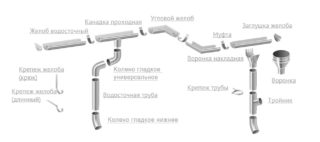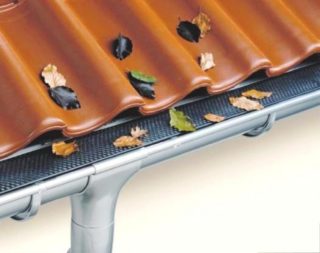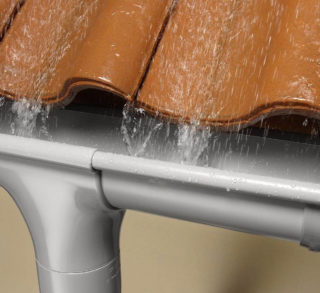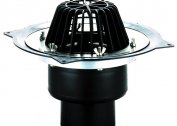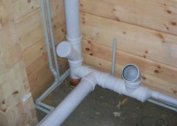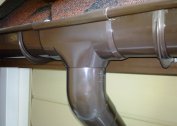The popularity of steel galvanized gutter systems was at its peak in the 80-90s of the 20th century. The construction industry does not stand still, and now thin steel sheet has improved technical characteristics. As a result, the demand for galvanizing is increasing again. Thin steel sumps are installed both in private buildings and in commercial ones.
Specifications galvanized gutter system
Structurally, all communication has the form of separate elements connected in series - gutters, funnels, vertical drainpipes. Additional fixation is provided by self-tapping screws, brackets, clamps.
Galvanized steel has the following specifications:
- operation of the material in the temperature range from -60 to +135 degrees;
- fire safety;
- inertness to aggressive environments;
- strength and resistance to mechanical stress of moderate intensity;
- low weight of products;
- the thickness of the zinc coating is from 10 to 60 microns.
The quality of the finished steel sheet always complies with GOST 16523-89.
Mounting Features
There are several ways to mount a drain from galvanization, depending on the general structure of the building and the design idea. Specialists distinguish such methods of a drainage device:
- External. All elements are located outside the box of the house. Horizontal gutters are mounted under the roof slopes, and vertical pipes are visible to the human eye. This method is relevant for regions in which there is not a large amount of snowfall and prolonged minus temperatures. Otherwise, ice can form in the gutters.
- Interior. Vertical pipes are placed behind the external curtain wall. This is done to hide communication from prying eyes and thereby preserve the exterior of the house, as well as to protect galvanized elements from winter freezing.
Sometimes experts resort to a combined method of installing steel drainage. Vertical pipes are laid behind the hinged facade, and their fastening is made external. The main advantages of this method are simple assembly of the structure, good protection of pipes against freezing.
Mount the drain in the following sequence:
- To the outer front board or the rafters of the roof frame, special brackets for the gutters are fixed. They are placed in increments of 50-70 cm, depending on the capacity of the tray. The larger it is, the smaller the distance between the hooks should be.
- When fixing the brackets observe a bias towards the funnel. It is made at the rate of 0.5-1 cm for each running meter of the gutter. Control the slope with a control cord stretched from the first to the last bracket. In addition, each hook should ultimately hold the tray under the roof so that there is no more than 15 cm from the ramp to the gutter.
- After mounting the hooks, a receiving funnel is installed.
- Fasten the receiving trays, connecting them together. The surface area of the gutter 1/3 should go under the roof slope.
- Install a vertical drainpipe. If necessary, bypass the ledges of the building frame using special transitional elbows.
- The pipe is additionally fixed to the box at home with clamps in increments of 80-100 cm.
The finished system must be checked for throughput and tightness.
Principles of operation and maintenance
When operating a drainage system made of thin steel, it must be remembered that the main enemy of the metal, namely its zinc top layer, is abrasives and sharp objects (branches, stones). They move along with the water flows, clog the gutters / pipes and damage their inner walls. As a result, the zinc layer cracks and the steel corrodes. To protect the system, it is advisable to adhere to such recommendations:
- Initially mount the protective gratings on the gutters. They can be perforated, slotted, and also made of light polymer or the same steel.
- Once every six months it is worth cleaning the system from small debris. It is advisable to clean the branches, leaves with soft brushes, but in no case with sticks or sharp objects.
- Once a year or at the beginning of each season, you need to rinse the drain to prevent clogging of funnels or vertical pipes.
If one of the elements fails (scratched, bent), it is better to replace it immediately. Otherwise, the functionality of the entire drainage system will be several times lower than expected.
Advantages and disadvantages of the galvanized gutter system
The popularity of steel galvanized gutters is due to such advantages of the material and the communication itself:
- Light weight elements. All components can be transported by personal passenger transport. Installation of steel drainage can be done independently.
- Inertness to ultraviolet. Unlike polymer painted elements, the zinc coating does not fade, does not change its shade. The exception is those components that are additionally covered with colored paints before implementation.
- Resistant to moisture. Due to the protective zinc coating, thin steel does not rust for 15 years or more.
- Inertness to aggressive impurities in water. The decision to galvanize steel made it possible to protect it from the negative effects of acids, alkalis, ammonia, etc.
- Saving performance over a wide temperature range. Zinc coated steel is not prone to expansion or other deformations due to temperature changes. And this means that the tightness of the system remains complete.
- Long service life. A properly installed system can be used for up to 20 years or more.
- Reasonable prices for elements of a drain.
The only drawback of galvanized steel is its low level of sound insulation. The noise of rain and hail residents of the house will hear fully.
Product Prices
The prices of drainage systems made of galvanized steel include all the necessary elements for the installation of a complete drainage system. Average cost of components:
- horizontal gutters - 130-250 rubles / meter;
- the angle of the gutter - 300 rubles. and higher;
- drain vertical pipe - 220-400 rubles / meter;
- funnel - from 450 rubles .;
- transitional elbow - from 330 rubles;
- bracket - 70-200 rubles .;
- clamps - 70-90 rubles.
The price of each metal element varies slightly depending on the thickness of the steel and the applied layer of galvanization. When buying components, it is important to pay attention to the accuracy of the geometry of the products. Only in this case the drainage system will be assembled without flaws, and the trays and pipes will become butt-to-head without hassle.

